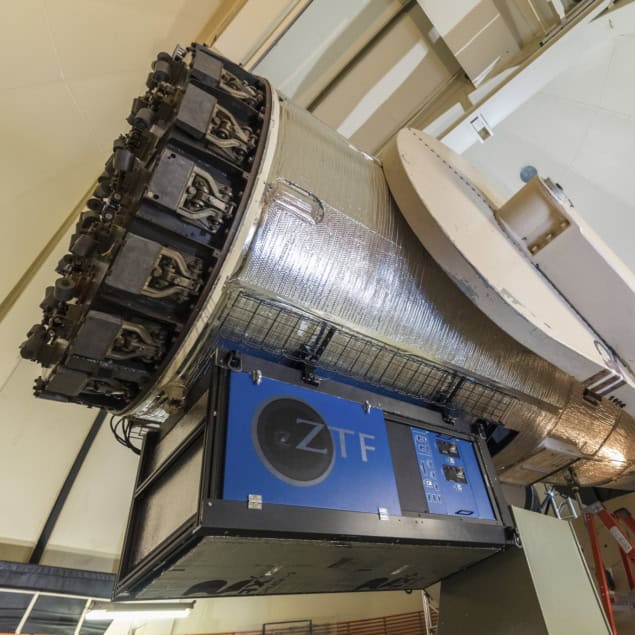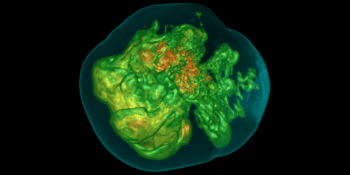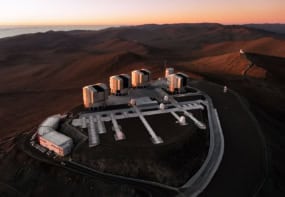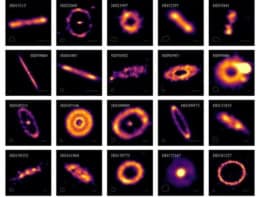Shrinivas Kulkarni won the 2024 Shaw Prize in Astronomy for his work on variable and transient astronomical objects. He spoke to Hamish Johnston about his approach astronomical research and the role that technology played in his many scientific successes

What does Shrinivas Kulkarni finds fascinating? When I asked him that question I expected an answer related to his long and distinguished career in astronomy. Instead, he talked about how the skin of sharks has a rough texture, which seems to reduce drag – allowing the fish to swim faster. He points out that you might not win a Nobel prize for explaining the hydrodynamics of shark skin, but it is exactly the type of scientific problem that captivates Kulkarni’s inquiring mind.
But don’t think that Kulkarni – who is George Ellery Hale Professor of Astronomy and Planetary Sciences at the California Institute of Technology (Caltech) – is whimsical when it comes to his research interests. He says that he is an opportunist, especially when it comes to technology, which he says makes some research questions more answerable than others. Indeed, the scientific questions he asks are usually guided by his ability to build technology that can provide the answers.
Kulkarni won the 2024 Shaw Prize in Astronomy for his work on variable and transient astronomical objects. He says that the rapid development of new and powerful technologies has meant that the last few decades been a great time to study such objects. “Thirty years ago, the technology was just not there,” he recalls, “optical sensors were too expensive and the necessary computing power was not available.
Transient and variable objects
Kulkarni told me that there are three basic categories of transient and variable objects. One category covers objects that change position in the sky – with examples including planets and asteroids. A second category includes objects that oscillate in terms of their brightness.
“About 10% of stars in the sky do not shine steadily like the Sun,” he explains. “We are lucky that the Sun is an extremely steady star. If its output varied by just 1% it would have a huge impact on Earth – much larger than the current global warming. But many stars do vary at the 1% level for a variety of reasons.” These can be rotating stars with large sunspots or stars eclipsing in binary systems, he explains.
It might surprise you that every second, somewhere in the universe, there is a supernova
The third and most spectacular category involve stars that undergo rapid and violent changes such as stars that explode as supernovae. “It might surprise you that every second, somewhere in the universe, there is a supernova. Some are very faint, so we don’t see all of them, but with the Zwicky Transient Facility (ZTF) we see about 20,000 supernovae per year.” Kulkarni is principal investigator for the ZTF, and his leadership at that facility is mentioned in his Shaw Prize citation.
Kulkarni explains that astronomers are interested in transient and variable objects for many different reasons. Closer to home, scientists monitor the skies for asteroids that may be on collision courses with Earth.
“In 1908 there was a massive blast in Siberia called the Tunguska event,” he says. This is believed to be the result of the air explosion of a rocky meteor that was about 55 m in diameter. Because it happened in a remote part of the world, only three people are known to have been killed. Kulkarni points out that if such a meteor struck a populated area like Southern California, it would be catastrophic. By studying and cataloguing asteroids that could potentially strike Earth, Kulkarni believes that we could someday launch space missions that nudge away objects on collision courses with Earth.

At the other end of the mass and energy range, Kulkarni says that studying spectacular events such as supernovae provides important insights into origins of many of the elements that make up the Earth and indeed ourselves. He says that over the past 70 years astronomers have made “amazing progress” in understanding how different elements are created in these explosions.
Kulkarni was born in1956 in Kurundwad, which is in the Indian state of Maharashtra. In 1978, he graduated with an MS degree in physics from the Indian Institute of Technology in New Delhi. His next stop was the University of California, Berkeley, where he completed a PhD in astronomy in 1983. He joined Caltech in 1985 and has been there ever since.
You could say that I live on adrenaline and I want to produce something very fast, making significant progress in in a short time
A remarkable aspect of Kulkarni’s career is his ability to switch fields every 5–10 years, something that he puts down to his curious nature. “After I understand something to a reasonable level, I lose interest because the curiosity is gone,” he says. Kulkarni adds that his choice of a new project is guided by his sense of whether rapid progress can be made in the field. “You could say that I live on adrenaline and I want to produce something very fast, making significant progress in in a short time”.
He gives the example of his work on gamma-ray bursts, which are some of the most powerful explosions in the universe. He says that this was a very fruitful field when astronomers were discovering about one burst per month. But then the Neil Gehrels Swift Observatory was launched in 2004 and it was able to detect 100 or so gamma-ray bursts per year.
Looking for new projects
At this point, Kulkarni says that studying bursts became a “little industry” and that’s why he left the field. “All the low-hanging fruit had been picked – and when the fruit is higher on the tree, that is when I start looking for new projects”.
It is this restlessness that first got him involved in the planning and operation of two important instruments, the Palomar Transient Factory (PTF) and its successor the Zwicky Transient Facility (ZTF). These are wide-field sky astronomical surveys that look for rapid changes in the brightness or position of astronomical objects. The PTF began observing in 2009 and the ZTF took over in 2018.
Kulkarni says that he is fascinated by the engineering aspects of astronomy and points out that technological advances in sensors, electronics, computing and automation continue to transform how observational astronomy is done. He explains that all of these technological factors came together in the design and operation of the PTF and the ZTF.
His involvement with PTF and ZTF allowed Kulkarni to make many exciting discoveries during his career. However, his favourite variable object is one that he discovered in 1982 while doing a PhD under Donald Backer. Called PSR B1937+21, it is the first millisecond pulsar ever to be to observed. It is a neutron star that rotates more than 600 times per second while broadcasting a beam of radio waves much like a lighthouse.
“I was there [at the Arecibo Observatory] all alone… it was very thrilling,” he says. The discovery provided insights into the density of neutron stars and revitalized the study of pulsars, leading to large-scale surveys that target pulsars.
When you find a new class of objects, there’s a certain thrill knowing that you and your students are the only people in the world to have seen something
Another important moment for Kulkarni occurred in 1994, when he and his graduate students were the first to observe a cool brown dwarf. These are objects that weigh in between gas-giant planets (like Jupiter) and small main-sequence stars. “When you find a new class of objects, there’s a certain thrill knowing that you and your students are the only people in the world to have seen something. That was kind of fun.”
Kulkarni is proud of his early achievements, but don’t think that he dwells on the past. “This is a fantastic time to do astronomy. The instruments that we’re building today have an enormous capacity for information delivery.”

He mentions images released by the European Space Agency’s Euclid space telescope, which launched last year. He describes them as “gorgeous pictures” but points out that the real wonder is that he could zoom in on the images by a factor of 10 before the pixels became apparent. “It was just so rich, a single image is maybe a square degree of the sky. The resolution is just amazing.”
And when it comes to technology, Kulkarni is adamant that it’s not only bigger and more expensive telescopes that are pushing the frontiers of astronomy. “There is more room sideways,” he says, meaning that much progress can be made by repurposing existing facilities.
Indeed, ZTF and PTF both use (used) the Samuel Oschin telescope at the Palomar Observatory in California. This is a 48-inch (1.3 metre) facility that saw first light 75 years ago. With new instruments, old telescopes can be used to study the sky “ferociously” he says.
Kulkarni told me that even he was surprised at the number of papers that ZTF data have spawned since the facility came online in 2018. One important reason, says Kulkarni, is that ZTF immediately shares its data freely with astronomers around the world. Indeed, it is the explosion in data from facilities like the ZTF along with rapid improvements in data processing that Kulkarni believes has put us in a golden age of astronomy.
Beyond the technology, Kulkarni says that the very nature of the cosmos means that there will always be opportunities for astronomers. He muses that the universe has been around for nearly 14 billion years and has had “many opportunities to do some very strange things – and a very long time to cook up those things – so there’s no shortage of phenomena to explore”.
Great time to be an astronomer
So it is a great time to consider a career in astronomy and Kulkarni’s advice to aspiring astronomers is to be pragmatic about how they approach the field. “Figure out who you are and not you want to be,” he says. “If you want to be an astronomer. There are roughly three categories open to you. You can be a theorist who puts a lot of time understand the physics, and especially the mathematics, that are used to make sense of astronomical observations.”
At the other end of the spectrum are the astronomers who build the “gizmos” that are used to scan the heavens – generating the data that the community rely on. The third category, says Kulkarni, falls somewhere between these two extremes and includes the modellers. These are the people who take the equations developed by the theorists and create computer models that help us understand observational data.
“Astronomy is a fantastic field and things are really happening in a very big way.” He asks new astronomers to, “Bring a fresh perspective, bring energy, and work hard”. He also says that success comes to those who are willing to reflect on their strengths and weaknesses. “Life is a process of continual improvement, continual education, and continual curiosity.”
- You can listen to Shrinivas Kulkarni in conversation with Hamish Johnston in this episode of the Physics World Weekly podcast: “Shrinivas Kulkarni: 2024 Shaw Prize in Astronomy winner talks about his fascination with variable and transient objects“.




